Palm Sunday Year A – Passion Sunday
Sunday March 29, 2026
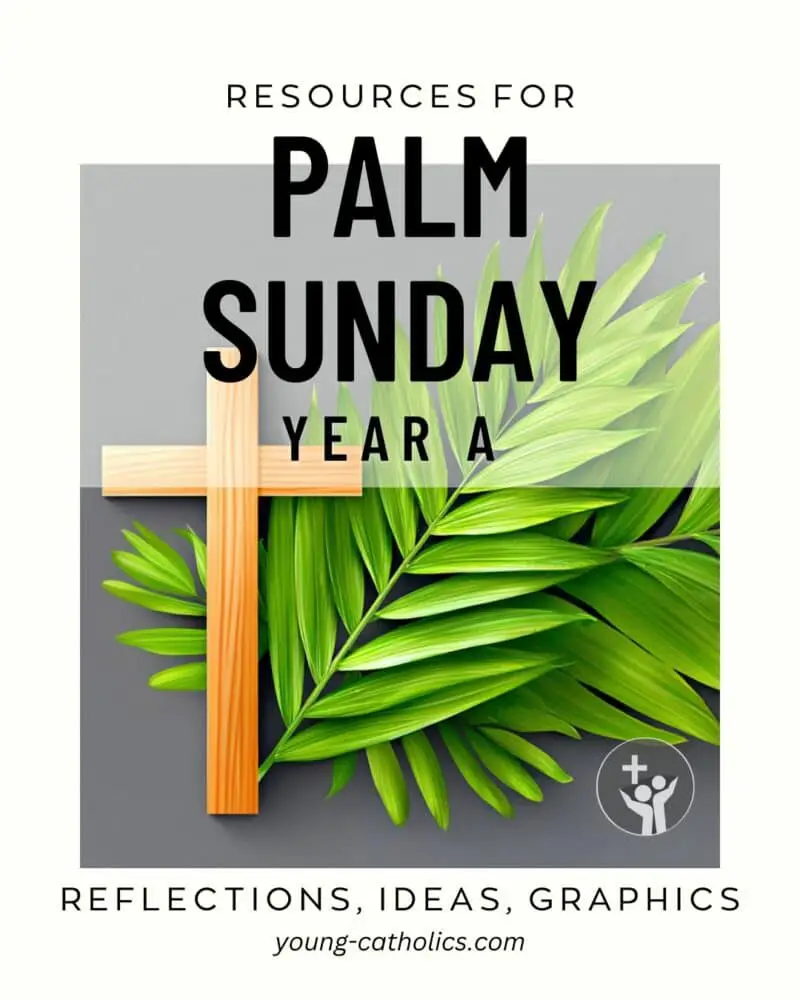
The King Who Rides a Donkey
Palm Sunday Year A remembers the day Jesus came into Jerusalem as a humble king. Crowds welcomed him with palm branches and shouts of praise. They called him the Son of David, showing they believed he was the promised Messiah. Yet, the week ahead would bring both joy and deep sorrow.
This day marks the beginning of Holy Week. It is a time to walk with Jesus in his final days before the cross. Palm Sunday Year A invites us to see the contrast between the cheers of the crowd and the suffering that is to come.
We hold palm branches to remember that Jesus’ kingdom is built on peace and service. His way is different from the world’s idea of power. As we reflect on this day, we are called to follow him in humility and love.
Mass Readings for Palm Sunday Year A – Passion Sunday
- Procession – Matthew 21:1-11: Jesus’ triumphal entry into Jerusalem, where he rode on a donkey and was greeted by crowds of people who praised him as the Son of David and King of Israel.
- First Reading – Isaiah 50:4-7: The prophet Isaiah speaks of a servant of God who is a skilled teacher and obedient to God’s will, even in the face of persecution and suffering. The servant trusts in God’s protection and ultimately prevails over his oppressors.
- Responsorial Psalm – Psalm 22: This psalm describes the anguish of a suffering individual who feels abandoned by God and is mocked and persecuted by others. Despite this, the speaker expresses trust in God’s ultimate protection and proclaims God’s glory to others.
- Second Reading – Philippians 2:6-11: This passage describes the selfless humility of Jesus Christ, who, despite being divine, chose to become human and submit to a humiliating death on a cross. As a result of his obedience, God exalted him and gave him a name above all others, that every knee should bow and every tongue confess that Jesus Christ is Lord.
- Gospel – Matthew 26:14 – 27:66: The Passion reading describes the events leading up to Jesus’ crucifixion and death. It includes Jesus’ betrayal by Judas Iscariot, his arrest and trial before the high priest, his denial by Peter, his sentencing by Pilate, his crucifixion and death, and his burial in a tomb.
Lectionary Reference: 37 and 38
Upcoming dates: March 29, 2026, March 25, 2029, March 21, 2032
The crowds preceding him and those following kept crying out and saying: “Hosanna to the Son of David; blessed is the he who comes in the name of the Lord; hosanna in the highest.”
Matthew 21:19
Themes for Palm Sunday Year A – Passion Sunday
Palm Sunday Year A remembers Jesus’ entry into Jerusalem and the events leading to his death. The readings show his humility, suffering, and obedience to God.
- Jesus as King: The people welcomed Jesus as a king, but he came in humility, riding a donkey. This shows that his kingship is different from earthly rulers.
- Obedience to God: Jesus followed God’s will, even when it led to suffering and death. His obedience shows trust in God’s plan.
- Betrayal and Denial: Judas betrayed Jesus, and Peter denied knowing him. These show human weakness and the need for mercy.
- Suffering and Sacrifice: Jesus endured pain, humiliation, and death on the cross. His suffering was an act of love for others.
- God’s Victory: Jesus’ death was not the end. God raised him up, showing that good is stronger than evil.
- Jesus as Servant: He did not seek power or glory. He humbled himself and served others, even in suffering.
Palm Sunday Year A calls people to follow Jesus’ example of humility, obedience, and love. It reminds them that suffering is not the end, but God brings hope and new life.
Resources for Palm Sunday Year A – Passion Sunday
Sunday March 29, 2026
- Lent and Triduum Cryptogram Puzzle
- Where Have You Been? (Reflection on the Passion of Jesus Christ)
- Attend the Mass of the Lord’s Supper
- Attend Good Friday Services
- Prayerfully Read the Passion of Our Lord
- More Lenten Ideas for Prayer, Fasting, and Almsgiving
- Procession Gospel from Matthew: A King Who Brings Peace
- The Book of Isaiah: The Servant Who Listens
- Psalm 22: From Anguish to Praise
- The Letter to the Philippians: Humility That Saves
- Passion Gospel from Matthew – The Way of the Cross

Lent and Triduum Cryptogram Puzzle
Palm Sunday Year A begins Holy Week, a time to reflect on Jesus’ suffering, death, and resurrection. The readings show his entry into Jerusalem, his betrayal, and his sacrifice. Lent and the Triduum help people prepare for Easter through prayer, fasting, and remembering these events. Learning about this season can deepen faith and understanding.
A Lent and Triduum cryptogram puzzle is a fun way for youth to explore these themes. It introduces key words like “Triduum” and “Good Friday,” helping them connect to the meaning of Holy Week. Palm Sunday Year A reminds people of Jesus’ journey to the cross, and activities like this can make those lessons more engaging.
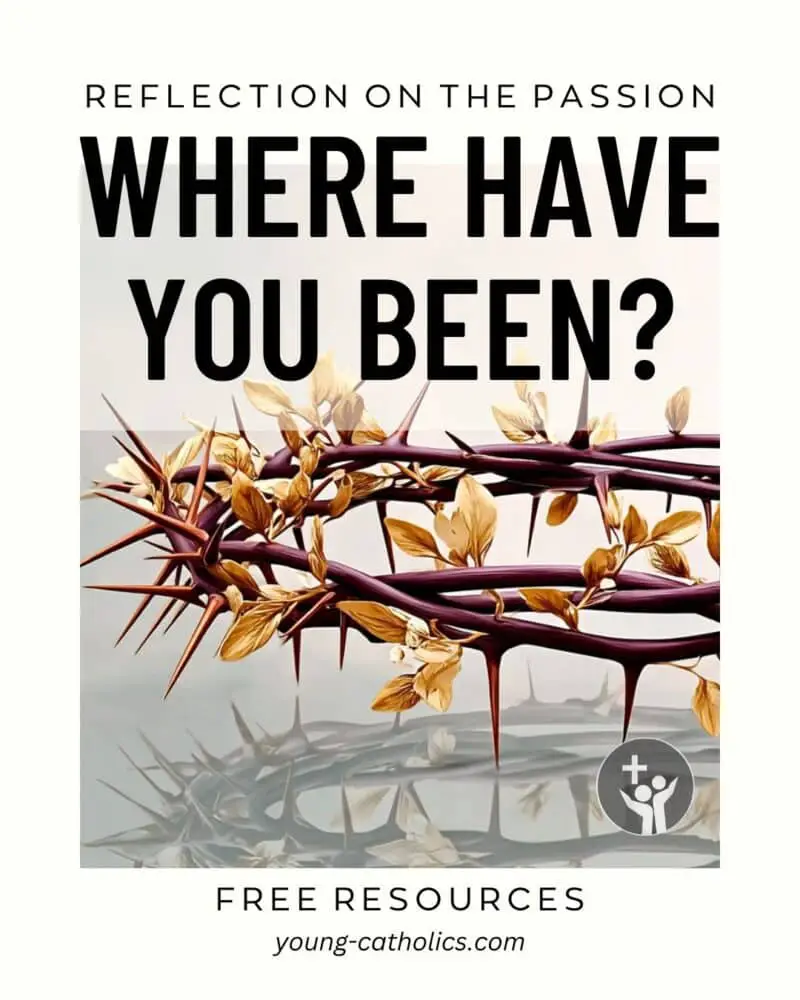
Where Have You Been? (Reflection on the Passion of Jesus Christ)
Palm Sunday Year A tells the story of Jesus’ suffering and the choices people made around him. Some stayed silent, afraid to speak up. Others denied him or followed the crowd. Jesus stood alone, accepting pain and rejection without fighting back. His silence before his accusers showed his trust in God’s plan. The readings remind people to ask themselves where they would have stood in that moment.
Palm Sunday Year A also invites people to respond to Jesus personally. He looks at them, just as he looked at his followers long ago, and asks them to walk with him. He does not promise comfort, but he promises his presence. Each person must choose whether to stay in the background or step forward in faith. Jesus’ suffering was not just a past event—it is a call to stand with him, to follow him, and to remain close even when it is difficult.
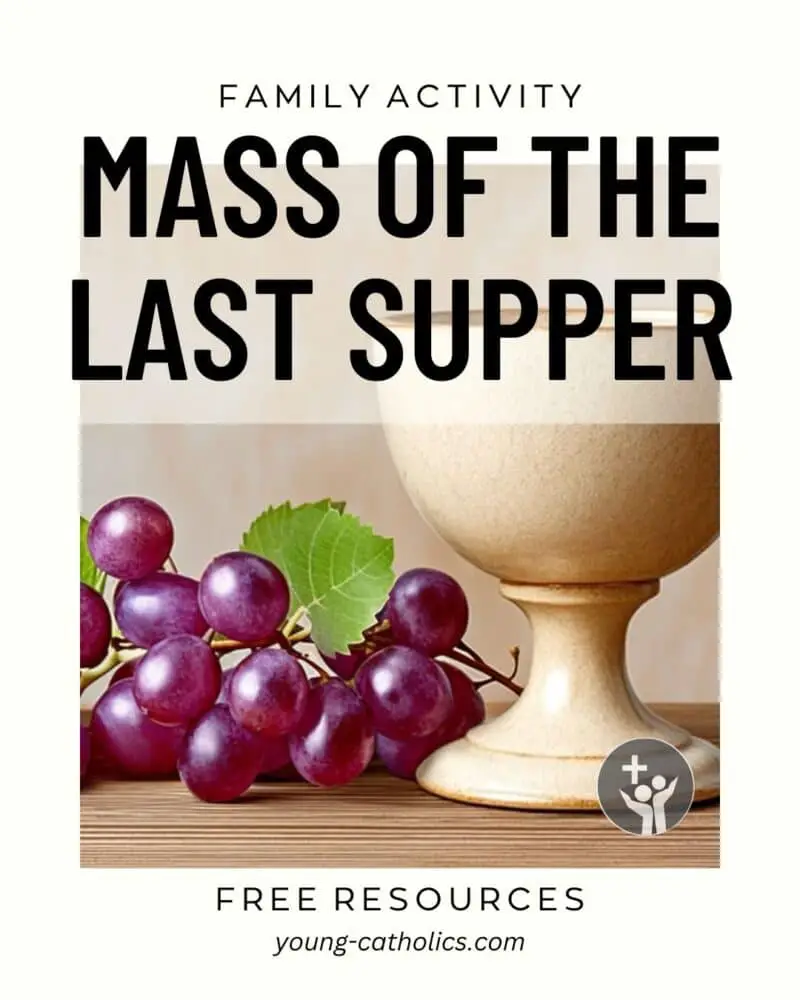
Attend the Mass of the Lord’s Supper
Palm Sunday Year A begins Holy Week and leads to the Triduum, the most sacred time in the Church. On Holy Thursday, Catholics remember the Last Supper, when Jesus gave his disciples the Eucharist and showed them how to serve by washing their feet.
This Mass marks the end of Lent and the start of the three-day journey toward Easter. The readings from Palm Sunday Year A remind people that Jesus willingly entered into suffering, and on Holy Thursday, he prepares for what is to come.
The Mass of the Lord’s Supper is different from a regular Mass. The altar is stripped, and the Eucharist is placed in a special location for adoration. This recalls Jesus praying in the Garden of Gethsemane before his arrest.
Just as his disciples were called to stay with him, people today are invited to keep watch and reflect on his sacrifice. Holy Thursday sets the stage for the suffering and victory of Easter.

Attend Good Friday Services
Palm Sunday Year A begins Holy Week by leading into Jesus’ suffering and death. The readings show how he was welcomed as a king but later rejected and crucified. Good Friday continues this story, marking the day of his sacrifice. There is no Mass, but Catholics gather for a solemn service to reflect on his death. The Passion is read, the cross is venerated, and Communion is received from hosts consecrated on Holy Thursday.
Palm Sunday Year A reminds people that Jesus willingly gave his life out of love. Good Friday is a day of mourning and prayer, calling Catholics to remember his suffering. The bare altar and silence at the end of the service reflect the weight of his sacrifice. As part of the Triduum, Good Friday connects to Holy Thursday and Easter, showing that suffering is not the end. Through his death, Jesus prepares the way for new life.

Prayerfully Read the Passion of Our Lord
Palm Sunday Year A tells the story of Jesus’ suffering and death, reminding people of his great love. The readings show how he was welcomed with joy but later betrayed and crucified. His sacrifice was not just for the world in general but for each person. Taking time to reflect on his Passion helps people see what he endured and why he did it.
Palm Sunday Year A invites people to place themselves in the story. Were they in the crowd cheering for Jesus, or did they stay silent when he was condemned? Personal reflection helps them grow closer to him. It makes his suffering more real and deepens their gratitude. By thinking about his pain and love, they can strengthen their faith and follow his example of selfless love.

Lenten Ideas for Prayer, Fasting, and Almsgiving
Palm Sunday Year A marks the beginning of Holy Week and reminds people of Jesus’ sacrifice. The readings show his suffering, obedience, and love. Lent prepares people for this moment through prayer, fasting, and almsgiving. These practices help them grow closer to God, remove distractions, and care for others in need.
Palm Sunday Year A connects Jesus’ Passion to the call for self-giving. Prayer strengthens faith, fasting teaches discipline, and almsgiving reflects Jesus’ love. By practicing these, people prepare their hearts for Easter. They learn to follow Jesus’ example of sacrifice and service to others.
See over 75 specific ideas here. Below are a few examples:
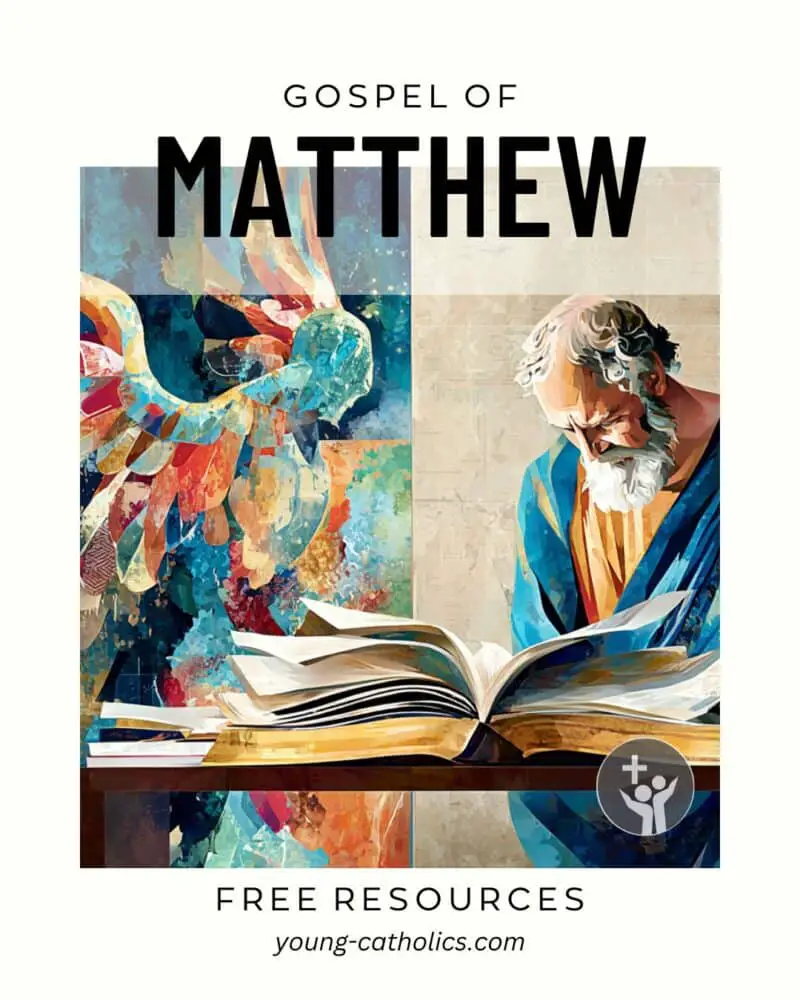
Procession Gospel from Matthew: A King Who Brings Peace
In Matthew’s Gospel, Jesus’ entry into Jerusalem fulfills Old Testament prophecy and reveals his role as the promised Messiah. Riding on a donkey shows his kingship is one of humility and peace, not military power. This scene in Palm Sunday Year A sets the stage for the events of the Passion.
Matthew often highlights how Jesus fulfills Scripture and reveals God’s plan. The cheering crowds who call him Son of David connect to the Gospel’s theme of the Kingdom of Heaven. Yet, their expectations differ from the kind of kingdom Jesus brings.
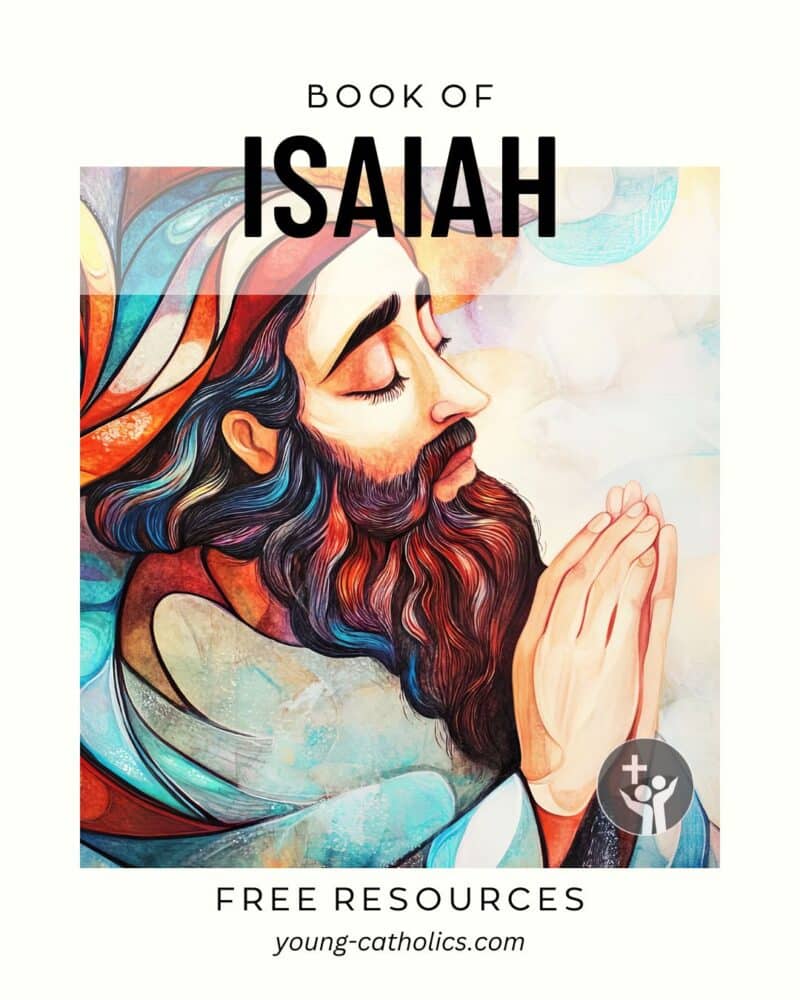
The Book of Isaiah: The Servant Who Listens
Isaiah’s prophecy speaks of a servant who listens to God’s word and obeys, even when faced with suffering. This fits with Isaiah’s broader focus on God’s plan to bring hope through faithful witnesses. In Palm Sunday Year A, it connects to Jesus’ willing acceptance of his mission.
The servant’s trust in God’s help echoes Isaiah’s theme of God’s faithfulness to those who depend on him. Despite rejection, God’s servant will not be defeated. This gives hope to all who face trials.
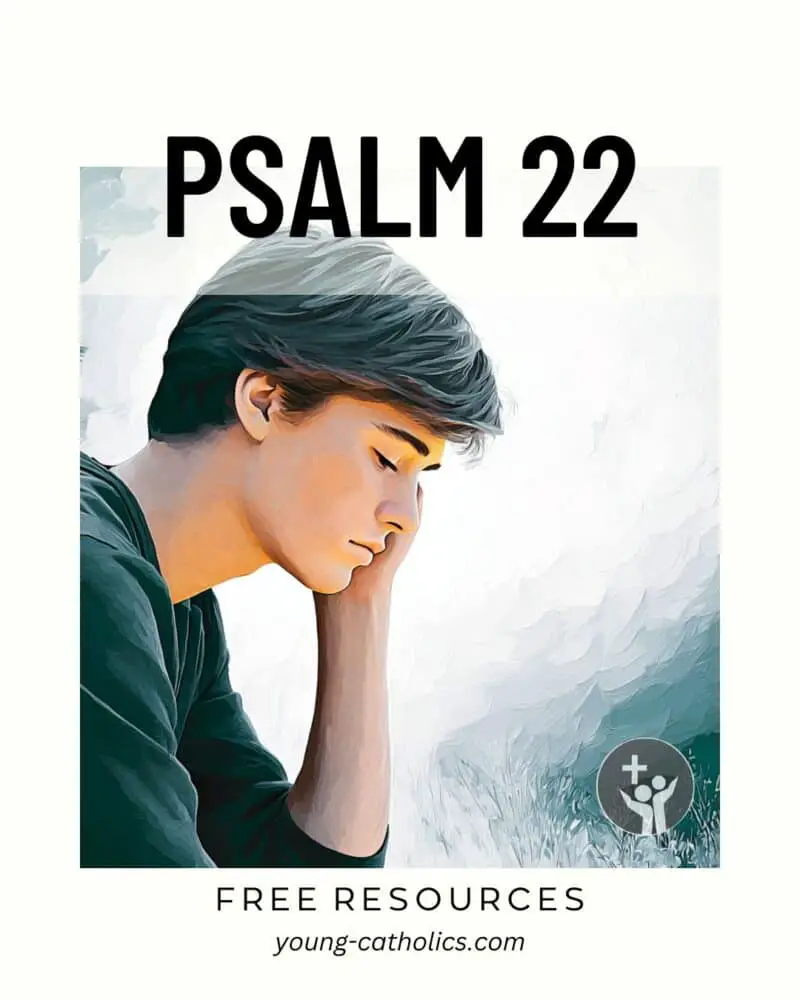
Psalm 22: From Anguish to Praise
Psalm 22 begins with deep sorrow and a feeling of abandonment. This honest prayer reflects the psalmist’s raw experience of suffering. In Palm Sunday Year A, these words mirror Jesus’ own cry from the cross.
The psalm moves from lament to praise, showing trust that God hears and saves. It reminds believers that pain can lead to a greater witness of God’s power.
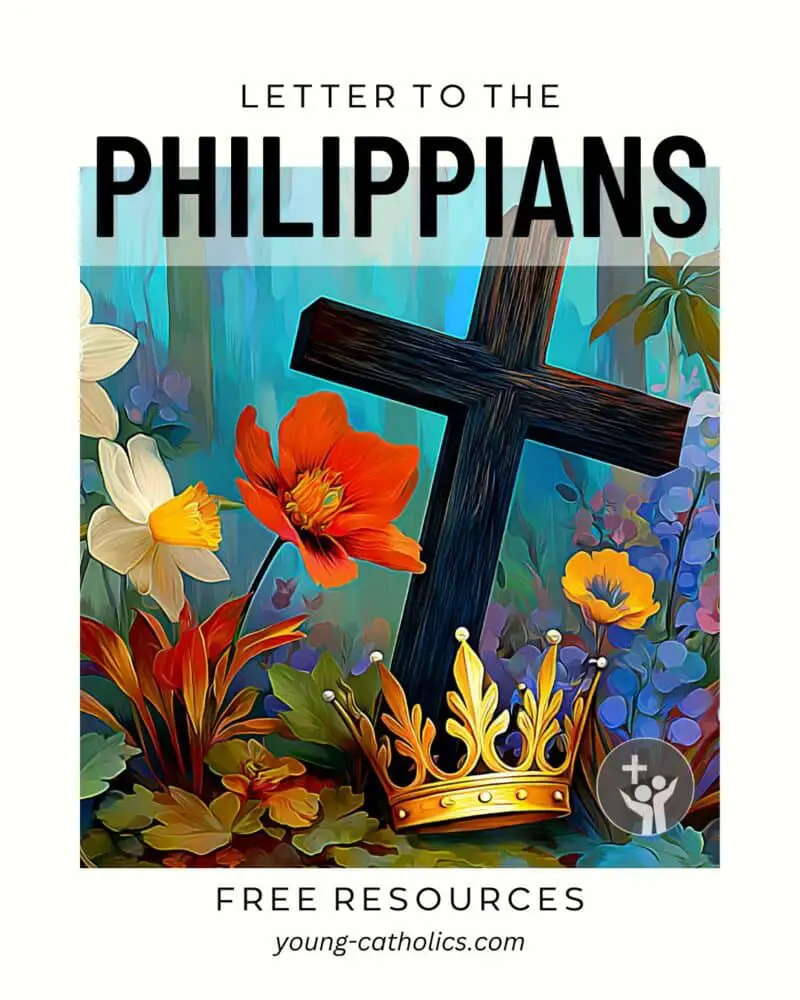
The Letter to the Philippians: Humility That Saves
In Philippians, Paul shows Jesus as the perfect example of humility. He lets go of status to serve, even to death. In Palm Sunday Year A, this reminds believers that self-giving love is the path to glory.
This passage fits Philippians’ larger message of unity and joy in Christ. True greatness comes from service and trust in God’s plan.

Passion Gospel from Matthew: The Way of the Cross
Matthew’s account of the Passion shows Jesus as the faithful Son who fulfills God’s plan. The details connect back to earlier parts of the Gospel where Jesus teaches about the cost of discipleship. In Palm Sunday Year A, it is the heart of the liturgy.
Matthew emphasizes Jesus’ kingship, even in suffering. From the trial before Pilate to the mocking by soldiers, the theme of Jesus as King is clear. The cross becomes his throne.
Homilies and Commentaries for Palm Sunday Year A – Passion Sunday
Sunday March 29, 2026
All the Way Down
Bishop Robert Barron’s homily for Palm Sunday Year A reflects on a passage from Philippians that describes Jesus’ humility and obedience. Though he was in the form of God, he chose to lower himself, becoming a servant and accepting death on a cross. This act of love was not weakness but true power. Jesus showed that greatness comes not from grasping for status but from self-giving love. Palm Sunday Year A reminds people that Jesus willingly entered suffering to bring them back to the Father.
Bishop Barron explains that because of Jesus’ obedience, God exalted him, and all are called to recognize him as Lord. Jesus went all the way down into human suffering so that he could lift people up. Palm Sunday Year A calls people to follow this path of humility, service, and trust in God. By surrendering to God’s will, they are drawn into the love that unites the Father, Son, and Spirit.
The Cross as the New Tree of Life
Jeff Cavins’ reflection for Palm Sunday Year A connects Jesus’ passion to the story of Adam and Eve. In the Garden of Eden, sin cut humanity off from the Tree of Life. Through his sacrifice, Jesus restores that access. The Eucharist, offered by the new priesthood, is the fruit of the cross, which is the new Tree of Life. Palm Sunday Year A highlights how Jesus, the true Lamb of God, gave his life so that people could receive eternal life.
Jeff Cavins also reflects on the choice between Jesus and Barabbas. Barabbas, whose name means “son of the father,” was guilty, yet the people chose to set him free. Jesus, the innocent Son of God, took his place, just as he takes the place of all sinners. Palm Sunday Year A reminds people to be grateful for Jesus’ sacrifice, which opens the way to life, forgiveness, and union with God.
Praying Through Holy Week
Fr. Mike Schmitz shares a reflection on how to pray during Holy Week, inspired by the Franciscan Sisters of the Eucharist. Palm Sunday Year A is called Procession Sunday, a day to walk with Jesus as he enters Jerusalem. The week begins with Commitment Saturday, focusing on Jesus’ decision to follow the Father’s will. Each day has a special meaning, such as Extravagance Monday, remembering the woman who poured perfume on Jesus, and the Day of Aloneness on Wednesday, reflecting on both Jesus and Judas.
Palm Sunday Year A leads into the Triduum, where Jesus gives his body on Holy Thursday and experiences complete powerlessness on Good Friday. This is a day when there is “no law” because people turned against their own God. Holy Saturday is a time of waiting in the darkness of the tomb. Everything leads to Miracle Sunday, when Jesus rises, showing that he has conquered death and brought hope to the world.
Which King? Whose Kingdom?
Bishop Robert Barron’s homily for Palm Sunday Year A focuses on Jesus as a different kind of king. Unlike worldly rulers, Jesus enters Jerusalem in humility, riding a donkey. He does not seek power through force but through love and service. The people celebrate his arrival, just as they did for King David, but they do not fully understand his mission. At the Last Supper, Jesus teaches that true greatness comes from serving others, not from seeking status. His kingdom is not built on domination but on self-giving love.
Palm Sunday Year A also shows the battle between Jesus’ kingdom and the false kingdoms of the world. The disciples argue over who is the greatest, while Jesus teaches that true leaders serve others. Peter denies Jesus, and the authorities accuse him, showing the worldly desire for power and control. On the cross, Jesus is mocked as a king, yet his love proves stronger than any earthly rule.
All Is Fulfilled
Scott Hahn’s commentary on Palm Sunday Year A highlights how Jesus’ passion fulfills the words of the prophets. His suffering and death were foretold, and through them, he brings salvation to the world. He is the Suffering Servant described by Isaiah, mocked, beaten, and crucified. Yet, he remains faithful, trusting that God will not abandon him. The new covenant is sealed in his blood, and his sacrifice frees humanity from sin and death.
Palm Sunday Year A reveals Jesus’ perfect obedience to the Father’s will. Unlike Adam’s disobedience, which brought sin, Jesus’ obedience brings life. Because of this, God exalts him, and salvation is found in his name. Those who follow his example of humble faith will never be abandoned. The centurion at the cross recognizes the truth—Jesus is truly the Son of God. His sacrifice opens the way for all to find freedom and eternal life.
Reflection for Palm Sunday Year A – Passion Sunday
Palm Sunday Year A begins the journey of Holy Week, the most important time in the Church year. The readings show both the joy of Jesus’ entry into Jerusalem and the suffering he faced in his final days. The people welcomed him as a king, but soon he was betrayed, denied, and sentenced to death. His suffering was not only physical but also emotional and spiritual. He experienced rejection, abandonment, and humiliation. Yet through it all, he remained faithful and trusted in God.
Suffering and Abandoned
The readings for Palm Sunday Year A show the joy of Jesus’ arrival in Jerusalem and the deep suffering he faced in the days that followed. The people welcomed him with cheers, waving palm branches and calling him their king. But soon, everything changed. He was betrayed, arrested, and sentenced to death. The same crowds that praised him later called for his crucifixion.
Jesus endured pain, rejection, and humiliation. He was beaten, mocked, and left to carry his cross alone. Even his closest friends abandoned him. Peter, who had promised to stand by him, denied knowing him three times. Judas, one of his own disciples, betrayed him for money. In his suffering, Jesus felt completely alone.
On the cross, Jesus cried out, asking why God had forsaken him. This moment shows his deep pain, but it also connects him to anyone who has ever felt abandoned. People sometimes feel distant from God in times of suffering. Jesus understands this because he experienced it himself.
Even in his darkest hour, Jesus remained faithful. He did not fight back or seek revenge. He trusted that his suffering had meaning. Palm Sunday Year A reminds people that suffering is part of life, but they are never truly alone. Jesus knows what it is to feel abandoned, and he walks with them in their pain.
Where Am I?
Palm Sunday Year A invites people to place themselves in the story of Jesus’ passion. There were many different people involved, each with their own reactions. Some welcomed Jesus with joy. Others turned against him. Some stayed close, while others ran away. It is worth asking, where would we have been?
Would we have been in the crowd, cheering for Jesus as he entered Jerusalem? Or would we have been annoyed by the commotion, not wanting our routine disturbed? When Jesus was arrested, would we have stood by him, or would we have denied knowing him like Peter?
Maybe we would have been like Simon of Cyrene, carrying the cross without wanting to, forced into service. Or perhaps like the women who stood by Jesus at the cross, refusing to leave him even when things got dangerous. Would we have helped, like Joseph of Arimathea, who gave Jesus a tomb? Or would we have joined the crowd in mocking him?
Palm Sunday Year A challenges people to reflect on their own faith. Do they stand by Jesus only when it is easy, or do they follow him even when it is hard? It is easy to say we love God, but our actions show where we truly stand.
Am I Willing to Follow?
The readings for Palm Sunday Year A show that following Jesus is not always easy. He does not promise an easy life. He asks people to follow him in humility and service, even when it leads to suffering. Are we willing to follow him in this way?
Jesus showed what true love looks like. He put others before himself. He accepted suffering instead of running from it. He forgave even those who hurt him. This is not the way of the world. The world teaches people to seek power, comfort, and success. Jesus teaches them to serve, sacrifice, and love.
It is easy to admire Jesus from a distance. It is harder to live as he did. Following him means choosing kindness over selfishness, patience over anger, and trust over fear. It means carrying our own crosses, whatever they may be. It means forgiving when it is difficult and loving even those who hurt us.
Palm Sunday Year A asks a simple but difficult question: Are we willing to follow Jesus, no matter the cost? He showed the way, but each person must choose whether to walk it.
The passion story is not just about the past—it challenges people today. It asks them to reflect on their own faith, their willingness to follow Jesus, and their response to suffering. Palm Sunday Year A reminds them that true greatness comes from humility and love. As Holy Week begins, they are invited to walk with Jesus, to stand by him in his suffering, and to follow his example of selfless love.
Prayer
Lord, you walked the path of suffering with love and patience. You were betrayed, denied, and abandoned, yet you remained faithful. Help me to follow your example. Give me strength in hard times, courage to stand by you, and a heart willing to serve others. Teach me to love as you love. Amen.
Reflection Questions for Palm Sunday Year A – Passion Sunday
- What does Jesus’ suffering teach me about facing difficulties in my own life?
- Have I ever felt abandoned by God? How does Jesus’ experience on the cross help me understand this feeling?
- In what ways do I stand by Jesus when it is easy, and when do I struggle?
- How do I respond when I see others suffering? Do I offer help, or do I turn away?
- Who in the passion story do I relate to the most, and why?
- How can I practice humility and service in my daily life?
- What are the “false kingdoms” I am tempted to follow instead of Jesus?
- Do I seek recognition and power, or do I choose to serve others quietly?
- How can I better trust God when I face struggles or suffering?
- What steps can I take to follow Jesus more closely during Holy Week?
Social Media Graphics and Bulletin Artwork for Palm Sunday Year A – Passion Sunday
Hosanna and the Cross

Bring the joy and meaning of Palm Sunday to your parish or ministry materials with this vibrant image of a cross and palm branches. Perfect for bulletins, newsletters, and worship aids, it captures the hope and triumph of Christ’s entry into Jerusalem.
Download it today to share the beauty of this sacred celebration with your community.
Paid subscribers may download a large copy this digital artwork without watermarks, suitable for use in bulletins, social media, newsletters, etc., free of charge by clicking here. You must be logged in as a paid subscriber to access the file.
Only current paid subscribers have the rights to use the artwork.
Music Suggestions for Palm Sunday Year A – Passion Sunday
Sunday March 29, 2026
For Palm Sunday Year A, music selections should reflect the themes of triumph and sacrifice. Songs that celebrate Jesus’ entry into Jerusalem with praise and hosannas are fitting for the beginning of the liturgy. As the readings shift to the Passion narrative, music should become more reflective, focusing on Jesus’ suffering and his journey to the cross. Hymns that express sorrow, love, and redemption help us meditate on his sacrifice and prepare our hearts for Holy Week. This blend of praise and solemn reflection echoes the liturgical movement of Palm Sunday Year A – Passion Sunday.
- All Glory, Laud, and Honor by St. Theodulph
- Behold the Cross by Bob Hurd
- Behold the Lamb of God by Matt Maher
- Crown Him with Many Crowns by Elvey
- Hosanna by Hillsong United
- Hosanna / Praise Is Rising by Paul Bloche
- Hosanna to the Son of David by Dan Schutte
- Hosanna to the Son of David by Tom Booth
- Lead Me to the Cross by Hillsong United
- My God, My God by Scot Crandal
- My God, My God by Timothy Smith
- O Sacred Head Surrounded by Tom Booth
- Remembrance by Matt Maher
- Sing Hosanna by Josh Blakesley
- Were You There? by Tom Booth
- What Wondrous Love Is This? by Josh Blakesley
- Who Is the Crucified? by Kevin Kell
Music directors and musicians are encouraged to explore these selections for Passion Sunday Year A. Consider the powerful themes of praise, humility, and sacrifice. Feel free to share your own ideas or favorite hymns in the comments. This is a wonderful opportunity to inspire others and enhance the liturgical celebration.
Questions and Answers for Palm Sunday Year A – Passion Sunday
What date is Palm Sunday Year A – Passion Sunday?
The next date is Sunday March 29, 2026.
For other years see the links below:
Palm Sunday Year A
Palm Sunday Year B
What are the Mass readings for Palm Sunday Year A – Passion Sunday?
The Mass readings for Sunday March 29, 2026 are:
Procession – Matthew 21:1-11: Triumphant Entry into Jerusalem
First Reading – Isaiah 50:4-7: The Suffering Servant
Responsorial Psalm – Psalm 22: A Cry of Anguish and a Song of Praise
Second Reading – Philippians 2:6-11: The Exaltation of Christ
Gospel – Matthew 26:14 – 27:66: The Passion of Christ
Why did Jesus ride a donkey into Jerusalem?
Jesus rode a donkey to show that he was a different kind of king. He came in peace and humility, not as a ruler seeking power.
Why did the people cheer for Jesus but later turn against him?
The people expected Jesus to be a powerful leader who would free them from Roman rule. When he did not meet their expectations, some turned away from him.
What does the first reading tell us about suffering?
The servant in the reading suffers but does not fight back. This shows trust in God and patience in hard times.
How does the second reading connect to Palm Sunday Year A?
The second reading shows that Jesus humbled himself and accepted suffering. Palm Sunday Year A reminds people to follow his example of humility.
Why did Jesus stay silent when people accused him?
Jesus knew his mission was to suffer and die for others. He did not defend himself because he trusted God’s plan.
How does Peter’s denial relate to us?
Peter was afraid and made a mistake, but later, he was sorry and changed. This shows that people can fail but still turn back to God.
What can we learn from Jesus’ suffering?
Jesus suffered without anger or revenge. People can learn to face hard times with patience and trust in God.
How does Palm Sunday Year A show Jesus as a servant?
Jesus did not seek power or fame. Palm Sunday Year A reminds people that he chose to serve others instead of ruling over them.
Why is Jesus’ death not the end of the story?
Jesus died, but God raised him to life. His story gives hope that suffering and death do not have the last word.
How can we live out the lessons of Palm Sunday Year A?
People can follow Jesus by being humble, serving others, and trusting God in hard times. Palm Sunday Year A encourages them to stay faithful even when life is difficult.
Sacrifice and Love
Palm Sunday Year A begins Holy Week by showing the joy and sorrow of Jesus’ journey to the cross. In the procession of the palms, we see Jesus entering Jerusalem as a humble and peaceful king, riding on a donkey. Crowds celebrate Him, waving palm branches and calling Him the Son of David. This fulfills Old Testament prophecies about the Messiah and shows Jesus as a leader who comes to save.
The Gospel readings for Palm Sunday Year A also remind us of the cost of this salvation. We see Jesus’ betrayal, arrest, trial, and crucifixion. His humility and obedience in the face of suffering and abandonment show His great love for humanity. Jesus even quotes Psalm 22 on the cross, crying out to God in His pain. Yet, the psalm ends in hope, reminding us of God’s presence, even in suffering.
The readings invite us to reflect on our own response to Jesus’ sacrifice. They ask us to consider whether we follow His example of love and selflessness. Holy Week is a chance to deepen our relationship with God and prepare for Easter by trusting in His presence and protection, even during hard times.
Your Turn
As we enter Holy Week, take time to reflect on the readings for Palm Sunday Year A. Think about Jesus’ sacrifice and how it impacts your life. Consider how you respond to His call to love, humility, and faith.
Share your thoughts in the comment section below. Which part of the readings speaks to you most? How do they challenge or encourage you? Your reflections may inspire others as we all journey together through Holy Week.

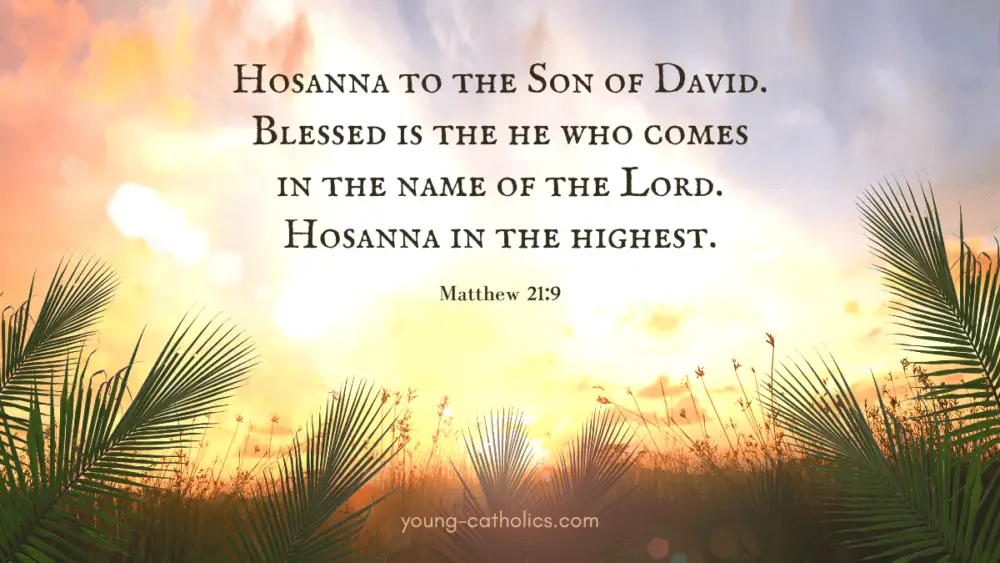
Leave a Reply